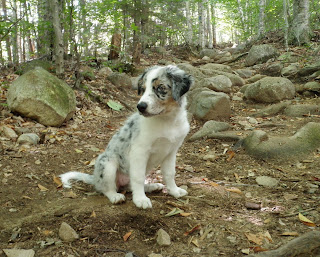 Here she is, your warm, dry, happy, puppy pic.
Here she is, your warm, dry, happy, puppy pic.There is nothing better than being warm and dry after you've gotten a little (or a lot!) cold and shivery during a rolling lesson or practice and find yourself getting even colder soon after you've gotten out of your boat as you pack up your gear. At the very least, this is your top concern of the moment.
Even on what seemed like a fairly warm day when you started, in a not so cold lake in which others are swimming in Speedos, you can get pretty cold during a rolling lesson. A rolling lesson for the rolling challenged is not the same thing as rolling practice for those who can roll. We, the "rolling challenged", tend to spend more time in the water, which is usually cooler than our body temps, and so do our great coaches in the shallows at our decklines! (Mine are getting pretty stretched out . . . ! I mean the decklines!)
Why do we get cold? At least me. I don't know about you.
Because we aren't really moving. Mostly we are sitting in our boat, dumping over, time and time again, trying to roll back up. When learning, most people fail and spend lots of time in the water. You are either hauled back to the top by your coach, or you wet exit and get yourself back in your boat.
All the spectators on land are warm and dry. Most of mine seem to have their arms crossed. Does that indicate concern or sympathy, I wonder? Distractions aside, you are starting to shiver sitting in your boat in your wet gear, mine is usually neo. People in dry suits seem to fair better, but who wants to practice rolling in a fairly warm lake in the summer with a full dry suit! This is expensive gear to own.
The most important thing for me, during a rolling lesson, is to take a break and paddle for a few minutes when I get cold. This warms me up quickly and relaxes me too. When my coach says, "Can you try that again in between shivers?", I know it's time to paddle a bit.
After a rolling lesson, or paddling in cooler temps, as soon as I get out of my boat, the first thing I do is peel off the wet gear and squeeze into something warm and dry. It's a happy feeling.
While we're on the topic of warm and dry and how happy it can feel to a paddler, this is a good opportunity to share some links and stories about the importance of staying warm. It also means being SAFE.
Every year we hear a story or two about a paddler who didn't make it back from a trip. It could be a simple day trip or something longer. Something happened, in good weather or bad. A common theme is hypothermia. Getting cold and staying cold for too long. It's not a good feeling to get cold and it can be deadly. It is an important topic for paddlers to be aware of. Even if you are wearing the proper gear, you can get stuck in the water for too long, or on a shoreline with a wind that seemed friendly but can chill you to the bone, and no help is on the way anytime soon. Even close to home. The water you are paddling on can be colder than you think.
One of my favorite sites that covers the topic of hypothermia is Coldwater Bootcamp. Nine water savvy and fit volunteers from across Canada jump into water we paddle and boat in and share their stories of how cold the water really is and how it affects them. I just wish this website would make it more apparent at what time of year the volunteers jumped in to the water and what water body they jumped in to.
And here's a pic of one of my favorite warm, dry, safe, paddling moments in Quebec's famed Saguenay fjord, despite three hours of rain and fog in June. A great guide and good gear just rock! And this is one of those incredible paddle places where you really need both!
 Wishing you warm, dry, safe and happy paddling wherever your paddle takes you!
Wishing you warm, dry, safe and happy paddling wherever your paddle takes you!The Baffin Paddler
Do you have a favorite warm, dry, paddle moment? One where you were so happy to be warm and dry? Where was it?
No comments:
Post a Comment